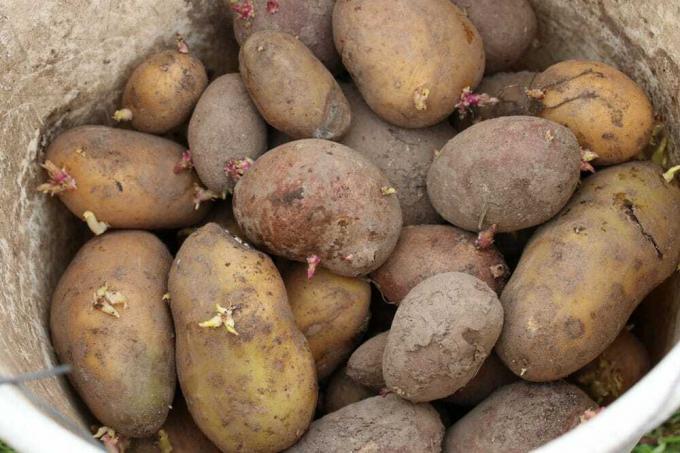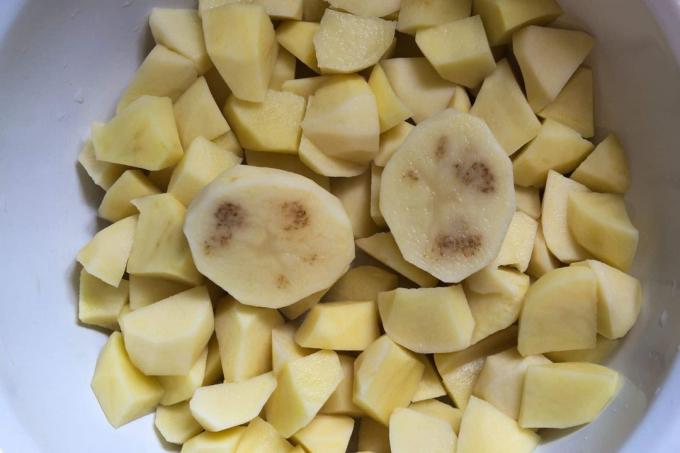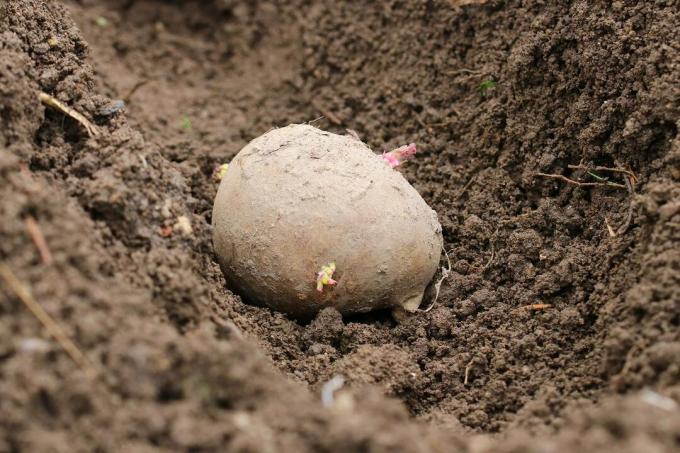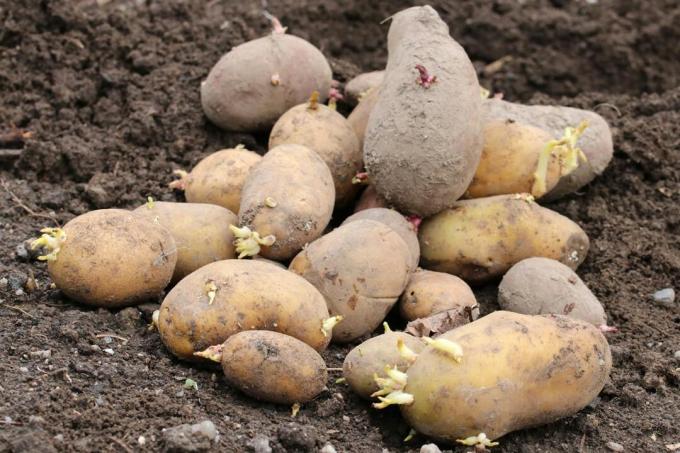

Table of contents
- solanine
- Solanine in potatoes
- Green spots
- Throw away or peel?
The potato, botanically Solanum tuberosum, is a species of the nightshade family (Solanaceae). In addition to the potato, the genus nightshade (Solanum) also includes other popular crops such as the aubergine (Solanum melongena) or the tomato (Solanum lycopersicum). The genus itself includes about 1,400 species. Many have parts that are toxic to humans, or are even completely toxic. The toxins of the nightshade family are called alkaloids. The best known are morphine, strychnine and solanine.
solanine
Solanine is a mildly toxic chemical compound found in potatoes. It is also commonly referred to as "tomatine," which is found in tomatoes, but has a different chemical composition. Solanine is heat-resistant, fat-insoluble and water-soluble at high temperatures, i.e. it goes into the cooking water. The lethal dose is 400 milligrams. The first signs of poisoning appear at a dose of 200 milligrams.
In adults, early signs include:
- drowsiness
- touch sensitivity
- difficult breathing
Continued solanine intake causes nausea and vomiting. These symptoms are also known as solanism.
Solanine in potatoes
Solanine is basically contained in every potato. 30 to 80 percent are located
- in the bowl
- right under the shell
Tip:
Solanine and other alkaloids are also found in the green parts of potatoes. That is why the aerial parts of the plant are poisonous to humans.

Breeding has drastically reduced the solanine content in the tubers. In a study from 1943, there were still isolated cases of almost 40 milligrams of solanine per 100 grams in one green potatoes, the solanine content in the skin of new varieties is around 3 - 7 milligrams per 100 grams Potatoes. In the potato body, the proportion is much lower. In all new varieties, the solanine content is considered harmless to health. The first symptoms of poisoning in new varieties only appear when a few kilos are eaten raw and unpeeled.
Tip:
The solanine content in older varieties can therefore be higher than in new potato varieties.
In nature, the bitter-tasting solanine protects the potato from pathogens, rotting agents and predators. Because of this, the solanine content increases slightly in bruised or peeled raw potatoes. The proportion of solanine also increases when potatoes have been exposed to light for a long time.
Tip:
Store potatoes in the dark. The ideal storage temperature is 10 degrees Celsius.
Green spots
Green spots on potatoes green potatoes contain more solanine than brown potatoes. The green spots on potatoes are formed after the solanine is formed and are actually from chlorophyll production. However, the intensity of the green color is an indication of the increased solanine content of the potato. The following applies: the greener, the more solanine there is in the tuber. Solanine production is stimulated by:
- warmth
- daylight
- Injuries to the tuber (frost or bruises)
Throw away or peel?
If parts of the potato have turned green, the whole potato does not have to be disposed of immediately. However, you should cut out the green areas generously. If the potato has turned completely green, it is not advisable to eat it, even if the solanine content is reduced by the preparation.

Tip:
The potato should also be cut out generously once it has sprouted.
In addition to solanine, potatoes with green spots also contain chaconine and leptins. The effect of these substances on the human body has not yet been extensively researched. Therefore, eating green potatoes is not recommended for
- people in poor health
- Children
- potato water
Since solanine is released into the water when potatoes are boiled, it must not be used further for cooking. Also, it shouldn't be drunk better. However, it can be used as a fertilizer or weed killers are used.
 Home editorial office
Home editorial office
Learn more about potatoes

Potato is brown inside: is it edible?
After peeling or cooking, a potato has brown to black spots on the inside. This doesn't look very appetizing at first. And above all, the question arises as to whether the potato is still suitable for consumption or not. Since the causes of this discoloration can vary, in some cases it is due to […]

Black spots on potatoes: still use them?
Potatoes can have black spots. The potatoes are almost always edible despite the black spots. However, affected potatoes may show changes in taste and texture.

Time: from and until when do you plant potatoes?
Potatoes are among the most widely grown vegetables. So that self-cultivation works and a lush harvest can be brought in over many months, self-cultivators should pay attention to one important point: the right time to plant.

Planting potatoes: distance and depth
The potato (Solanum tuberosum) is a staple food with a wide range of preparation options. The tubers are indispensable in many dishes and are tastiest when you pick them yourself. What could be more obvious than growing them yourself. You can do this without your own garden.

Mixed culture: 14 good neighbors of potatoes
German cuisine would be unthinkable without potatoes. Have you ever thought about growing the delicious tubers in your own garden? Use the advantages of a mixed culture! We present 14 plants that are suitable for mixed cultivation with potatoes.

Laying potatoes: ideal spacing and depth
Potatoes are good for the vegetable garden because they prepare the soil optimally for subsequent vegetables. They can also be stored for a long time and can be prepared in a variety of ways. You can read here which spacing is the right one for laying potatoes.



